×
[PR]上記の広告は3ヶ月以上新規記事投稿のないブログに表示されています。新しい記事を書く事で広告が消えます。
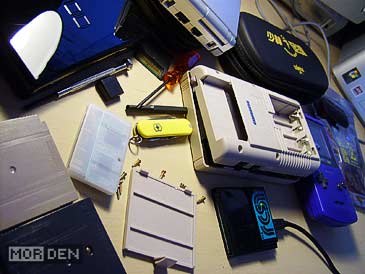
Oh man, I am a lazy bum and I admit it. It has been ages since I posted anything and I deserve a punishment. Too bad I'm out of everyone's reach and I get to get away with it - again. So why am I posting an entry now? Did something exciting happen? One could say so. I finally got my hands on a nice Game Boy DMG and Color flash unit, mainly for LSDJ purposes, which I think the cartridge sticker gives away. Since official LSDJ cartridges are no longer being manufactured, and haven't been for years, the developer, Johan Kotlinski, made the ROM image of the program available for purchase at a very low price of $2, directly from the LSDJ website.
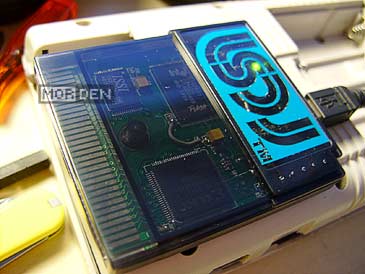
What is it and what does it do? The cartridge itself is a 64 Mbit USB Smart Card. The memory is divided into two 32 Mbit banks, which by simple calculation means, a maximum of 4 Mbytes can be stored in each one. Additionally, the device is equipped with a large amount of battery backed SRAM memory, which can be both written and read via the software client. This makes backing up of LSDJ songs and other save data extremely easy. The only downside is, the SRAM can hold data written by one application only. For example, if I were to save an LSDJ track, switch over to Carillon Editor and save one track as well, the data would either be overwritten or corrupted, leaving only the latest SRAM write fully functional and readable.
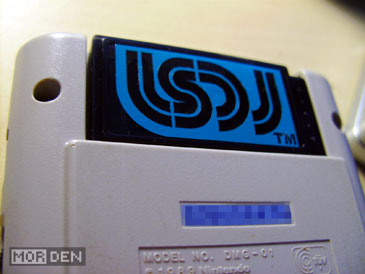
Now that I said a bit about the hardware, let me talk about the software instead. Some of you may already be familiar with LSDJ, as it is, alongside Nanoloop and Carillon Editor, immensly popular with chiptune artist and lo-fi musicians. In fact, one could say that LSDJ combines the functionality of both aforementioned programs to create the most versatile environment available on the Game Boy hardware. LSDJ is essentially a tracker - A music composing software which allows you to create your own sounds, but also comes with a wide range of samples. It was designed with stage performers in mind, allowing easy manipulation of pattern sets, etcetera.
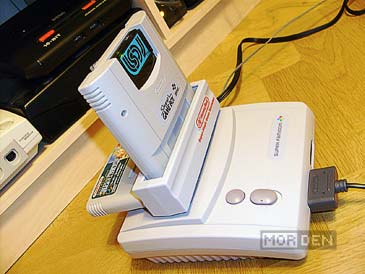
The LSDJ program is compatible with any hardware capable of running Game Boy dedicated software. This means you'll be able to create beats on your classic DMG, as well as on Game Boy Advance. It's also possible to run it on Super Game Boy, as seen in the photos. Since I mainly use a japanese Super Famicom Jr, I was forced to use a Honey Bee converter to boot up the SGB, but the positive results can be seen on the TV screen, even though the set-up used to achieve them doesn't look too sleek.
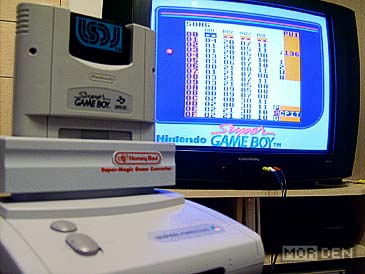
Why did I decide to go with the Smart Card solution for LSDJ? The answer is quite simple. The Smart Cards are high capacity and low cost, plus, unlike Bung cartridges, which are impossible to obtain nowadays, they use USB. Today, the only alternative to Smart Cards are BleepBloop cartridges developed by Jose A. Torres, and while they are superior in terms of design and reliability, they're only 16 Mbits and they cost a lot. This is mainly due to the design being more sophisticated and made to work like an original Game Boy cartridge. BleepBloop hardware has SRAM protection circuitry, as well as a memory controller identical to one seen in Nintendo's cartridges. The reliability factor is of greater importance to performing chiptune artists, than to simple folks like myself. Truth be told, I would buy a BleepBloop, but I'm cheap.
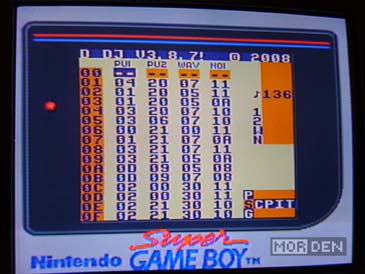
I have tested the cartridge on a multitude of devices, avoiding Game Boy Pocket, because supposedly, this model of Game Boy will simply suck the SRAM battery dry in no time. Same goes for Game Boy Light, since it's based on the same hardware design. So far, everything worked flawlessly. I have tested dozens of home-brew applications and games for both Game Boy Mono and Color, and everything seems to be running smoothly. The Smart Card certainly opens the door to a whole world of scene productions, and while these can be emulated, you and I both know it's never the same as running everything on real hardware.

I wanted to make a video showing the LSDJ in action, but instead I made a compilation of Game Boy Color cracktros and other scene productions. I shot it with the Eye Toy camera from the Game Boy Advance SP screen, because Game Boy Color screen is impossible to capture. However, I can assure you that everything works fine on both systems. I used a line-in for the audio, so enjoy some great chiptunes and stay tuned for the upcoming LSDJ presentation.
Before I wrap this entry up, I want to let everyone know that I might be posting an entry dedicated to music making software for the Game Boy. Over the years I've come across and collected many applications, most of them really simple, but still fun. Game Boy music making is a vast subject, but I'll try to cover the applications I myself consider to be most fun. That's it for me - It's 3AM and I'm off to bed.
PR

Last month I bought some really cheap games, and then I bought some more. This was due to a local store selling off all the old titles and those that just wouldn't sell for one reason or another. I pretty much swiped everything that was playable, but recently I went back to see if they added some new titles to the bargain bin, and they did. Nothing too exciting, but still a great bargain - four items for $20. I bought two PSP games, Popolocrois and Lumines: Puzzle Fusion, one GameBoy Advance game, Puyo Pop Fever and one useless gadget, an mp3 player for use with GameBoy Advance or Nintendo DS. I chose this last item only so that other three would qualify for the bargain deal.
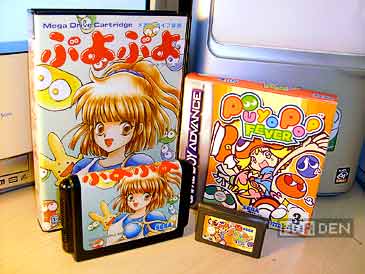
Who doesn't love a solid Tetris clone with a bunch of new ideas, lovable characters and better graphics? I know I do. I've been playing Puyo Puyo since, well, forever. It's certainly a great game, but it suffers the same problems as Tetris - It doesn't really change over the years. You can add more characters, you can compose a new and catchy soundtrack, but at its core, the game stays the same. Such is the deal with Puyo Pop Fever, which, aside from fever mode - a combo chain opportunity that will most likely crush your opponent - doesn't offer anything new.
Plus, I already own Puyo Puyo Fever for the Dreamcast, and the GameBoy Advance version is pretty much identical. I spent alot of time playing Fever on Sega's last console, so I'll probably spend some time with the pocket version of the game, and besides, who wouldn't buy it for $5? Next item on the list is the official Nintendo mp3 player. I once made a mistake and bought Datel's infamous Advance Music Player for GameBoy Advance and I promised myself never again to purchase an equally useless gadget. Whoops.
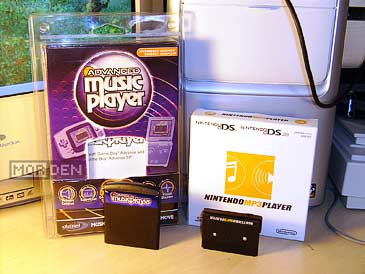
I was facing a choice of buying the mp3 player, or getting one of the EA sports games, so I went with the lesser of two evils. I'd rather own a gadget I know I won't use, than own a EA sports game I know I will not play. I did examine the device and it does look like a more thought-through product than that of Datel's. Instead of connecting directly to the PC via a USB cable, Nintendo's player features an SD card slot and it comes with a built in headphone jack, solving the problem of poor sound amplification. Datel's Music Player required special drivers to be properly detected by a PC computer and the player program was so unstable, it couldn't even handle file transfer without corrupting the data in most cases. Useless to me as it may be, Nintendo's solution proves itself superior in every aspect.

One weird thing, though - The device compatibility chart printed on the box lists the player to be incompatible with both GameBoy Advance and SP, but it is supposed to work with GameBoy Micro. I tested this myself and the player does in fact work fine with GameBoy Advance SP, so I don't know what the deal is here, but if you own a regular GBA or an SP and you want to get such a device, rest assured - it will work. Last, but not least, two new PlayStation Portable titles. One more puzzler and an RPG game. I have to admit, I don't have much time for RPG games these days, but I always wanted to get Popolocrois and I'm glad I could get it for cheap - Not that the game isn't worth more.
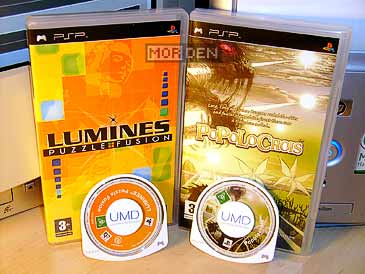
I'm almost always choosing old-school 2D RPGs over the high budget 3D ones. There's more to a story driven title than fireworks, and if a game like Suikoden can work better than any of the Final Fantasy titles, graphics-wise being on par while SuperFamicom productions, I think there is a strong point to what I've just said. Popolocrois is a pixly, isometric treat and I hope I will find time soon to play it. The series has enjoyed a lot of success in Japan during the PlayStation days, and now, I can enjoy two of the PSX games compiled into one story.
And then, there's Lumines. I love all of Tetsuya Mizuguchi's work. One could say he's all about rhythm, simple but expressive visuals and addictive game play. This has been the trademark of Space Channel 5 and REZ and it's the same with Lumines. While being a puzzle game, it still manages to incorporate music into the game to the point that the two are inseparable. I never owned the original PSP Lumines, so I'm glad I finally got to buy it. I did however spend some time playing it on my mobile phone, but Gameloft's J2ME counterpart is no match for the visuals and sound of PSP.
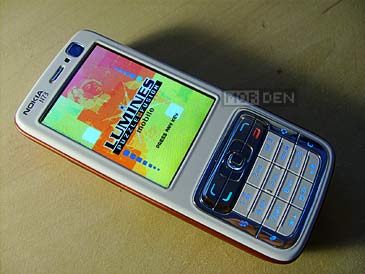
Aside from the mobile phone game, I also spent alot of time with freeware Lumines clones, the first and most important one being Block Smash - a freeware homebrew game released for the Dreamcast. I did also play Gleam on GameBoy Advance, which is another homemade clone. Like I said however, none of these, no matter how good, are a match for the original, and playing the real deal made me realize I've been missing out.
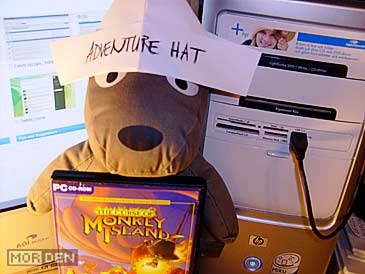
Looks like the time is nigh to put my adventure hat on, because pointing and clicking is back in style. I wish there was an adventure game hating person here right now, who never believed adventure games were any good, and to whom I could say "I told you so", because I always believed the time would come when people who enjoy a good puzzle and a funny joke would again be enjoying decent productions. Sadly, none of the people I know care that much about adventure games, or games in general.

Recently we've seen two big announcements from LucasArts and Telltale Games. They both, rather unexpectedly, admitted to be working on Monkey Island projects. While LucasArts made a remake of the classic The Secret of Monkey Island, Telltale Games announced a whole new Monkey Island series - Tales of Monkey Island, divided into seasons and episodes, much like the rest of their titles.

Not too long ago, I chose to pre-order Tales of Monkey Island, tempted by the Steve Purcell painted slipcase, which comes with the physical copy of the game, once all five episodes of the first season are out. Aside from the slipcase, all those who pre-ordered, got a coupon code for a free episode and access to an exclusive part of Telltale forums, Private Pirates Club, which before the game premiered was off limits for regular mortals. Now it's open for viewing, but all the topics are locked. Too bad I didn't leave my mark while I still could - Maybe I'll be able to post a question to Dominic Armato before the second episode premieres and I think of a question good enough to post in public.
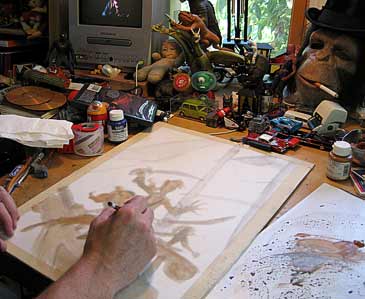
Before Tales of Monkey Island premiered, I used up my bonus code and got myself the very first episode of Wallace & Gromit's Grand Adventures. Since the episodes are $8,95 a pop, and there's only four of them in the first season, I figured it was a win-win situation for me. Telltale offers the first season bundle for $34,95, which hardly makes any difference whether you buy the season as a whole, or buy the episodes separately. Buying single episodes would set me back $35,8 and since I got one episode for free, all I have to do is pay $26,85 for the remaining ones, and I got myself a complete season with the disc.
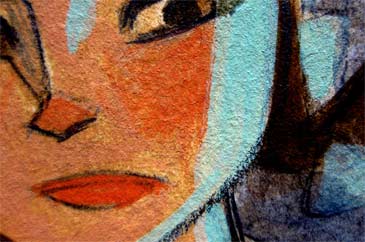
I was curious about the Wallace & Gromit game ever since it came out. I'm not too big on game demos, especially of those games I know I eventually want to get, so a free copy of Fright of the Bumblebees was a real treat for me. I already knew the characters all too well, so I wanted to know how did Telltale do this time around. After all, their Sam & Max series came out excellent, no matter what the fanboys want you to think.
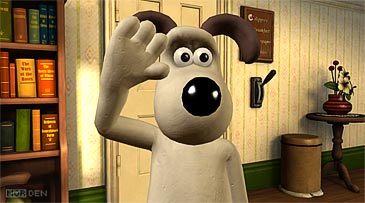
The Grand Adventure and Fright of the Bumblebees starts off, like any regular day, with breakfast. Lazy Wallace needs his nutrients, so naturally, our very first mission will be to feed him. I guess Telltale figured the best way to start off a game was to make you run chores. Let's stop there, because it sounds like I'm complaining, while in fact, fixing the breakfast is rather enjoyable and free of stress - And it can't be compared to the chaos Wallace and his inventions create later on.
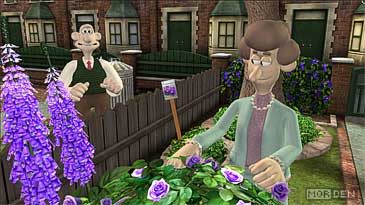
The plot is simple: Wallace got himself a debt he needs to repay, and he intends to do that by delivering no less than fifty gallons of honey to a local shop. The problem is, Wallace can't get the production going unless he comes up with an obscene amount of flowers to feed his bees. Being an inventor however, he quickly comes up with a totally unrealistic solution which gets everyone in trouble. I don't want to be spoiling too much, so let's leave the story and focus on the rest.
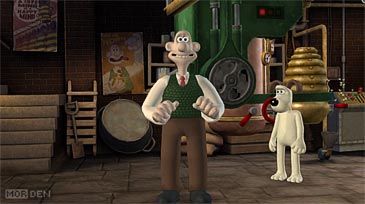
The game introduces new style of controls and setup. While Sam & Max was all about pointing and clicking, in Wallace & Gromit we'll move about using either the arrow keys, or the more familiar alternative to those who play first person shooters, "WASD". I personally prefer the mouse interface, but I had no real problems with Telltale's decision. The only frustration was caused by the movement being relative to the camera angle, so if you enter a new area and the camera changes, the detections might change a bit - Just like they did in Alone in the Dark or Resident Evil games.
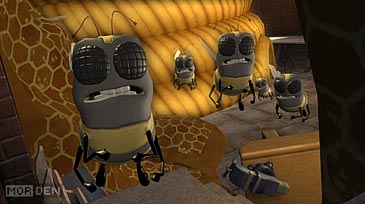
Everything else is spot on. Both sound and voice acting work great and those familiar with Wallace & Gromit series won't feel that something has changed. Graphics do their part as well. The characters try to look clay-like, and with some help from nice texturing, I'd say they pull it off. One thing I have noticed and thought was really cool was how the characters move and talk. Clay animation usually uses specific frames for vocals and the game mimics that really well. Same goes for Gromit's walk. He looks more like a clay model being animated, than a polygonal character with fluent moves, so props to the animators.
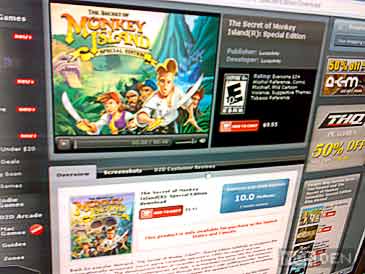
That about covers it for Wallace & Gromit - For now, because once I get the whole season and a game disc, I will most certainly talk about this title again. Now I would like to talk a little bit about The Secret of Monkey Island. Looks like someone at LucasArts realized there's still money to be made selling adventure games, but instead of making a proper sequel to Full Throttle or one of the Indiana Jones games, they decided to play safe and release a remake - Not that there's anything wrong with that.

Recently, LucasArts have released some of their classic adventure games as digital downloads on Valve's Steam and IGN's Direct2Drive. Since digital distribution is becoming more and more popular and big companies don't believe in retail success of adventure games, The Secret of Monkey Island: Special Edition got only a digital release on the previously mentioned services and on Xbox Live Arcade. What is a consumer to do, when a game is only available in digital form? Choose the lesser of three aforementioned evils. Since I already know how retarded Steam is, and I don't like digital downloads for consoles in general, I started considering Direct2Drive.
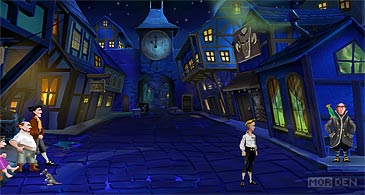
The problem with Direct2Drive is, they're racist. Why would I say such a thing? Because it's true. They tend to focus on United States based consumers and thus, making majority of the games available via their service inaccessible to people outside of the land of opportunity. However, as long as you can supply a valid US residential address and fake your IP, you're all set for sailing. Direct2Drive has one advantage over Steam - It doesn't come with a client that's hogging your computer's resources for no reason other than DRM protection.

The only problem is, you have to fake your way through the registration, payment and activation so that the service actually believes you're from the US of A. On top of that, the game is activated via Trymedia. What's Trymedia, you might wonder. Remember RealNetworks and their crappy, adware infested RealPlayer? Trymedia is basically a division of RealNetworks, specializing in DRMing the living hell out of everything using their evil ActiveMARK solution. But hey, it's still better than Steam, and you only need to activate the product once. After that, it's a standalone program without a client attached to it.
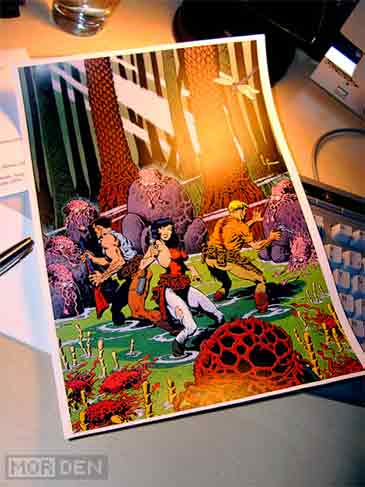
So now, I'm a happy owner of a digital copy of The Secret of Monkey Island: Special Edition and even though I haven't been able to play all that much since I'm still knees deep in Gobliiins 4, so far things are looking good. To make things even better, LucasArts made it possible to switch between the original CD version of the game and the remade Special Edition at any time using the F10 key. As soon as this game came out, investigative fans went to work and took everything apart. As it turns out, it is possible to extract the classic game and run it using the ScummVM engine interpreter.
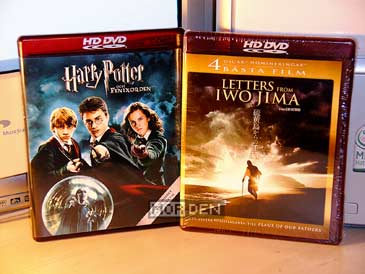
Another project that attracted a lot of attention, especially on the LucasForums, is an attempt to transfer the Special Edition voice over, only used in the upgraded version of the game, to the classic version of the game, creating a full "talkie" hybrid. I'm pretty excited about all of this, but I still hope that sooner or later LucasArts will release a retail version of this special edition.

In other, not so adventurous news, I'm finally done retouching my Xenozoic Tales poster by Mark Schultz. It had some fold marks, which I got rid of, and now it's ready for high resolution, big format printing. I also managed to score to new HD DVDs. I did invest in the Xbox 360 HD DVD drive, so I need all the movies I can find. Well, not really, but the obscenely cheap ones I'll buy, and these were only $3,8 a pop, and if that's not a good deal, I don't know what is. Also, I am still playing the classic Goblins, no matter where I go. Why won't the developers see to it that we get decent games on portable devices other than Nintendo DS and PSP? I own a Symbian OS 9.x phone and there are very few decent Symbian games, only Java crap. Luckily, I have ScummVM, because aside from emulation, only decent games I've found are those by Infinite Dreams.
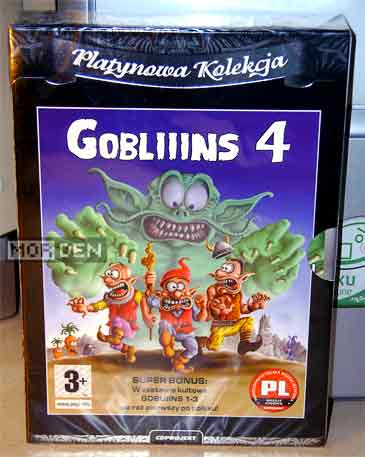
When I think of adventure games, especially those with a focus on some heavy puzzling, I always think of the Goblins series. Rarely has one game delivered such a huge amount of demanding puzzles. The greatness of Goblins doesn't end with its difficulty level, though. The series was always a complete package, featuring amazing graphics and memorable soundtracks. Now, the king of puzzlers is back to challenge us one more time.
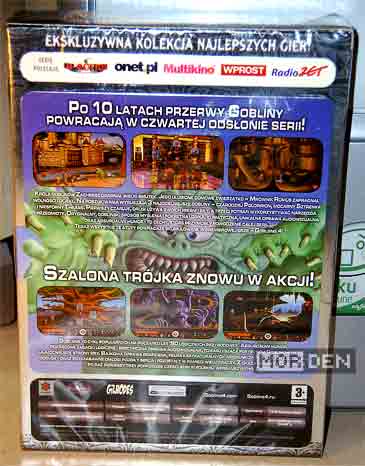
Just as quickly as the series appeared, it went off the radar back in 1993 and no one heard of it again, up until the year 2004, when Pierre Gilhodes officially announced the sequel. The wait was not over yet, as the years passed and the official website remained unchanged, without so much as a trace of an update. I remember writing about Gobliiins 4 back in 2007 - Back then I started to fear that Gobliiins 4 would be one of those unfortunate titles that end their lives in the fires of development hell.
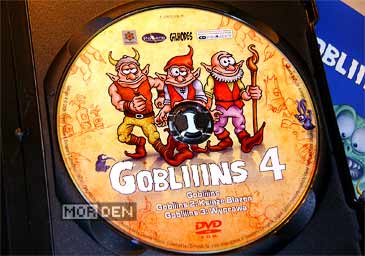
I tried to keep positive, seeing as many classic franchises got resurrected. After all, who would ever expect to see a new Sam & Max or Simon the Sorcerer title in the age of console gaming and a precious few adventures? So finally, in the year 2009 I got what I have been waiting for, after no more and no less than sixteen years. Gobliiins 4 was here.

As the number of i's in the title and the cover art suggest, once again we'll take control of three goblins, and thanks to the unique abilities of each and every one of them, we'll venture through puzzle filled rooms. Gobliiins 4, much like its predecessors, doesn't send you running from location to location. Each level is a single room, and once all of the puzzles in it are solved, you can move on and continue your journey to the next one.
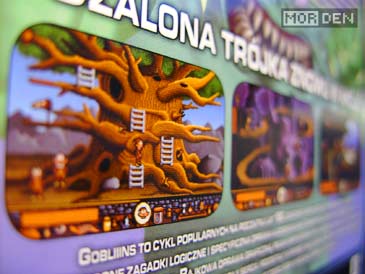
The story is as simple as can be. You, a goblin detective named Tchoup, get a letter from King Badigoince, instructing you to find your two friends and get your rear-ends to the castle - pronto. Being a faithful subject, Tchoup wastes no time and embarks on a search for Stucco and Perluis. Each of the characters has his own level and to gather a full party, you'll need to complete a number of chores made into puzzles. After that, it's off to the castle and so the story starts.

It's not the most exciting of plits, but Goblins games were never about the story. In fact, first three games didn't even have proper dialogs. All you could expect from the game was a few lines of text per level and that was that. When you saw a sleeping giant blocking your way, you couldn't just wake him up and ask him what he wants - the game wanted you to figure it out on your own, and that made Goblins so much tougher and more entertaining.
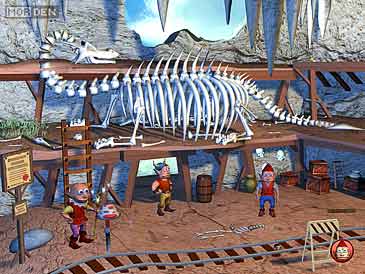
When compared to its prequels, puzzles in Gobliiins 4 have been noticeably toned down. While I could spend hours on end in a single room in any of the first three games, when playing the newest title in the series, I have no bigger problems with completing a level in just under one hour. Believe me, the difference in difficulty is huge, considering I could be figuring out a single stage from, let's say Goblins 3, for days.
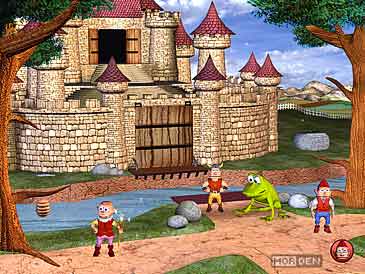
Back in the day games were tough, and that's a fact. Sometimes I felt as if developers didn't really care whether or not a normal thinking person could actually complete a given title. Goblins series was one of the toughest adventures around, but that was in the early nineties. I'm guessing the developers didn't want to punish those, who bought a $20 game and just wanted to have some fun, rather than pull their hair out and scream in frustration.
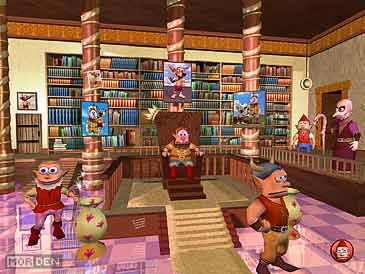
Puzzling and game-play aside, it's hard to overlook the fact that Gobliiins 4 doesn't really look like a game published in 2009, or 2004 for that matter - It's more of a blast from the past, with a fistful of indie spice. From what I can tell, the development team consisted of only few people, so one ought to think of Gobliiins 4 as a labor of love rather than your regular, commercial product.
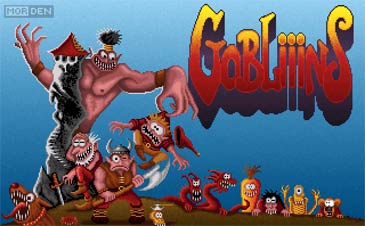
Truth be told, I don't mind the outdated look one bit. If anything, it contributes to the quirky feel that's always been a part of Goblins. All of the backgrounds are pre-rendered, with 3D models layered over them - much like in well known Alone in the Dark or Resident Evil. The goblin models aren't as detailed as those seen in Telltale Games' productions, but their animation is fluent and there are enough physical gags hidden throughout the game to keep you smiling from start to finish.
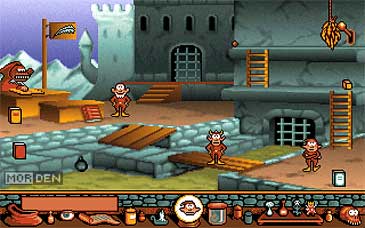
With the visual aspect of the game covered, let's talk a bit about the music. Sadly, the original artist, Charles Callet, doesn't return to compose the score, but his successor, Didier Sallustro aka Tonton Didou does a fine job as well. Some of the tunes sound like remixes of the old AdLib score from previous games, which earns the soundtrack a plus in my books. Overall the music is enjoyable, although it does tend to stop after a while, leaving only the ambience and sound effects. The only improvement I'd like to see in the sound department are the correctly handled loops - The rest is just great and I have absolutely no complaints.
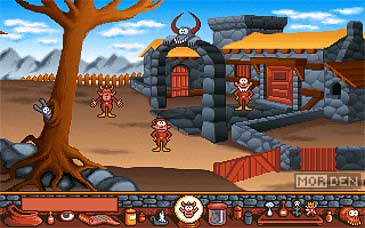
Gobliiins 4 wouldn't be a proper sequel if it didn't feature the peculiar goblin speech. Back in early nineties digitized speech was a rare sight, so first three games used this funny sounding "goobly-boop" talk, similar to what Rare used in their Banjo Kazooie games. It sounds a bit different this time around, more like snippets of normal speech played backwards, but it's adorable nonetheless. And yes, adorable is a proper word to describe this phenomenon.
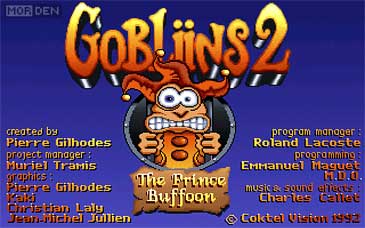
So, with sound described, we're ready to wrap this entry up, right? Wrong. The excitement of Gobliiins 4 doesn't end with the cover title. The developers were kind enough to include all of the three DOS games and that's the reason why you see these old-school screenshots. That's right - Thanks to ScummVM, we get to re-live and re-play first three games of the series. I know there are many of those, who never heard of Goblins, and the inclusion of previous games makes Gobliiins 4 a must have.
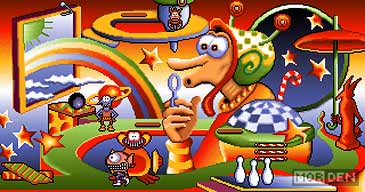
Gobliiins, Gobliins 2: The Prince Buffoon and Goblins 3 aka Goblins Quest 3 are all present and flawlessly emulated. As you may or may not know, each of these games got two releases, one being a regular floppy and another being a CD version with enhanced soundtrack. All of the classic games present on the Gobliiins 4 disc are the CD versions and this creates a small problem.
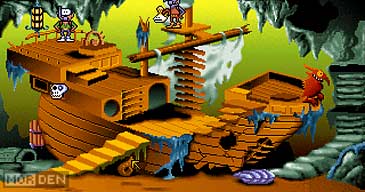
The way Goblins games were built didn't allow multiple soundtrack, so it was either the CD tracks or AdLib music. This means that those who got a floppy version were missing out on CD music and vice versa. To make matters worse, both the CD and floppy soundtracks are entirely different. So, in other words, buying Gobliiins 4, you are stuck with the CD soundtracks for Goblins 1 to 3. It's a shame really, since the AdLib soundtrack is generally considered to be superior to the CD one, which was often limited to ambience. Having CD quality environment sounds might have been impressive back in the early nineties, but anyone in their right mind would pick the AdLib music any day.
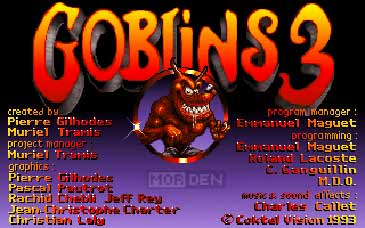
Another thing worth noting is that when you run one of the classic games, they're being started via a batch file. A ScummVM command is executed and you're being taken directly into the game. Old Goblins were originally DOS games and they're pretty low-res, but when you start the ones you get with Gobliiins 4, you might notice that the pixels are filtered and smoothened. This is because the batch files contain the following command: -ghq2x. Remove it, and you'll get the original pixly look. And remember that there's a separate batch file for each game.

The Gobliiins 4 version I bought is a so called MULTI3 edition, which means it uses three languages - in this case Polish, Czech and Hungarian. When poking around in the classic Goblins resources, I came across a small irregularity. Since the DOS games got localized, the intro.stk files present in Gobliins 2 and Goblins 3 filders are different than those from the '92 and '93 originals. Aside from obvious differences due to translation, additional 22 bytes were added to the file header, which made it impossible to unpack the file using ScummVM tools.

I have reported this on ScummVM boards and thanks to one of the developers, DrMcCoy this small error has already been fixed, so if you feel like playing around with the resources, grab the latest SVN build of ScummVM tools. Since I'm on the technical side of things, it's worth to mention that Gobliiins 4 doesn't use any kind of protection against copying other than the CD check. If you're anything like me, you hate being forced to have the game disc present in the drive at all times and that's why I created a small patch that takes care of this problem. You'll find download links at the bottom of the page.
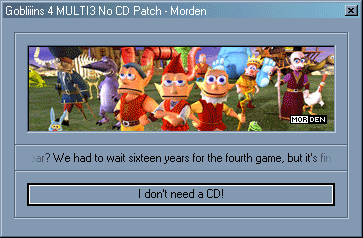
It is important that you understand this patch was not created to circumvent the copy protection, as there isn't any. You might just as well run a copy, as long as the disc is present in the drive. The patch overwrites four bytes in the launcher app to override the check and that's it. You can keep your precious disc inside the box and enjoy the game on all of your computers. We're living in a world where most people own a desktop computer as well as a laptop, so do we really need the game to ask us for the disc? No.

Since the original Goblins are emulated through ScummVM, you can easily take those games with you anywhere you go if you own a smartphone, PSP, Nintendo DS or any other portable platform that ScummVM has been ported to. So grab your flash cart and give it a try. This of course means you have to buy Gobliiins 4, but if you want to be among the people I respect and admire, you'll get this game anyway.
● - Gobliiins 4 No-CD Patch @ GameCopyWorld.com
● - Gobliiins 4 No-CD Patch @ RapidSpread.com
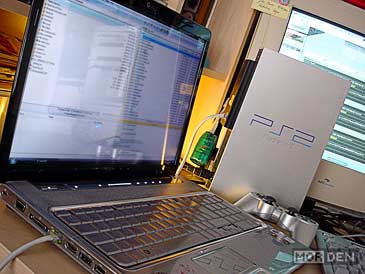
Memory cards with limited storage capacity are a thing of the past and today, no company would dare to sell a console, which forced its user to purchase a separate, custom made 256 megabyte flash drive. Unfortunately, when Sony designed their PlayStation 2, they thought that making us buy 8 megabyte memory cards was totally okay despite having the MemoryStick solution on the market for two years already. Naturally, everyone was running out of space.
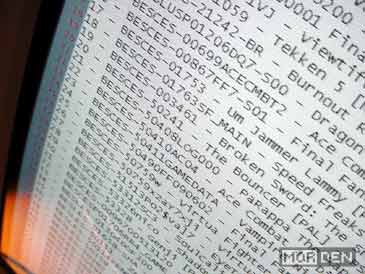
PlayStation 2 has two USB ports, but guess what - you can't use them for anything, except for the licensed peripherals. Just when you thought you can use your pen drive to store the save states, the reality kicks you in the head. Luckily, there is a way of transferring the files from the memory card to your PC via an FTP connection. That's what I always do when I'm running low on space. The save files are stored in directories named after serial number of the corresponding games. Sometimes the name will contain some letters which will hint at what the save is, but normally you have to figure it out.
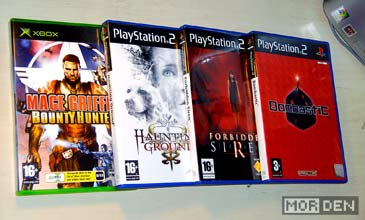
So that's what I occupied myself with today. I backed up all the save files, cataloged them and now I can start filling the card up yet again. In other news, I scored another $13 deal and got myself four PlayStation 2 titles - This is the direct reason why I'm emptying my card. The newcomers are: Mace Griffin: Bounty Hunter for the Xbox and Haunting Ground, Bombastic and Forbidden Siren for the PS2. I loved Devil Dice, so I'm really glad I scored a copy of its sequel, Bombastic. Sixteen games in under two weeks. Nice.
カレンダー
| 06 | 2025/07 | 08 |
| S | M | T | W | T | F | S |
|---|---|---|---|---|---|---|
| 1 | 2 | 3 | 4 | 5 | ||
| 6 | 7 | 8 | 9 | 10 | 11 | 12 |
| 13 | 14 | 15 | 16 | 17 | 18 | 19 |
| 20 | 21 | 22 | 23 | 24 | 25 | 26 |
| 27 | 28 | 29 | 30 | 31 |
カテゴリー
フリーエリア
最新CM
[02/23 jikoo]
[02/23 jikoo]
[02/21 sara]
[01/04 Inlagd]
[11/21 Inlagd]
最新記事
(01/31)
(01/27)
(01/04)
(11/14)
(11/12)
最新TB
プロフィール
HN:
No Name Ninja
性別:
非公開
ブログ内検索
最古記事
(12/17)
(12/19)
(12/23)
(12/25)
(03/30)
P R


